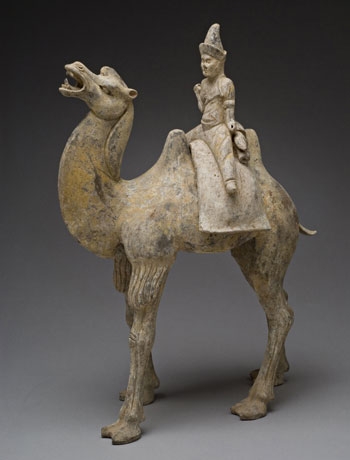
Camel and Rider is located in the Robert F. Reiff Gallery of Asian Art on the second floor of the Museum. Audio guide length: 2 minutes, 22 seconds.
Link to next piece in highlights tour: Shamaness Haniwa
Transcript
This sculpture portrays a man seated atop a camel. It is made of terracotta, baked clay, and is covered in faded yellow and black paint. It was made during the Tang dynasty, between 618–907. It is about 23 inches tall, 16 and ½ inches wide, and 8 and ½ inches deep, about the same height as from the floor to your knee or mid-thigh. The piece offers a glimpse into what life along the Silk Road may have been like.
In this sculpture, a Silk Road trader sits between two camel humps. He is wearing loose pants, a shirt with rolled up sleeves, and a pointed hat. He sports a beard and broad, bold facial features. The clothing and physical features of this rider identify him as a trader from Central Asia. He sits atop a cloth, with two rolled fabrics stored behind him.
This trader rides a two-humped Bactrian camel, native to central Asia, Mongolia, and northwestern China. The camel’s long legs steadily step forward and its head is dramatically reared back. Its mouth is open wide, revealing sharp teeth and a curled tongue. This impressive piece at once captures the realities of everyday life for traders, while also portraying the whimsical notions associated with camels during the Tang Dynasty.
[If you would like further description and analysis of this sculpture, please continue listening or reading.]
The Silk Road was a trading route over 4,000 miles long that linked China to the Mediterranean. It helped spread culture and civilization across the two continents. Silk Road traders often carried silk, tea, salt, sugar, and spices. These rolled fabrics tucked behind the trader may be silks intended for market. The trader has holes in his hands, indicating that he may have once held reigns or a whip made of perishable materials like leather or wood.